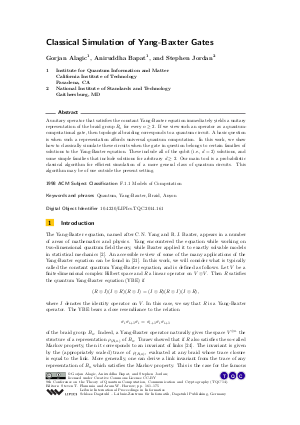Classical Simulation of Yang-Baxter Gates
Authors Gorjan Alagic, Aniruddha Bapat, Stephen Jordan
-
Part of:
Volume:
9th Conference on the Theory of Quantum Computation, Communication and Cryptography (TQC 2014)
Part of: Series: Leibniz International Proceedings in Informatics (LIPIcs)
Part of: Conference: Conference on the Theory of Quantum Computation, Communication and Cryptography (TQC) - License:
 Creative Commons Attribution 3.0 Unported license
Creative Commons Attribution 3.0 Unported license
- Publication Date: 2014-12-11
File

PDF
LIPIcs.TQC.2014.161.pdf
- Filesize: 421 kB
- 15 pages
Document Identifiers
Subject Classification
Keywords
- Quantum
- Yang-Baxter
- Braid
- Anyon
Metrics
- Access Statistics
-
Total Accesses (updated on a weekly basis)
0PDF Downloads0Metadata Views
Abstract
A unitary operator that satisfies the constant Yang-Baxter equation immediately yields a unitary representation of the braid group B_n for every n >= 2. If we view such an operator as a quantum-computational gate, then topological braiding corresponds to a quantum circuit. A basic question is when such a representation affords universal quantum computation. In this work, we show how to classically simulate these circuits when the gate in question belongs to certain families of solutions to the Yang-Baxter equation. These include all of the qubit (i.e., d = 2) solutions, and some simple families that include solutions for arbitrary d >= 2. Our main tool is a probabilistic classical algorithm for efficient simulation of a more general class of quantum circuits. This algorithm may be of use outside the present setting.
Cite As Get BibTex
Gorjan Alagic, Aniruddha Bapat, and Stephen Jordan. Classical Simulation of Yang-Baxter Gates. In 9th Conference on the Theory of Quantum Computation, Communication and Cryptography (TQC 2014). Leibniz International Proceedings in Informatics (LIPIcs), Volume 27, pp. 161-175, Schloss Dagstuhl – Leibniz-Zentrum für Informatik (2014)
https://doi.org/10.4230/LIPIcs.TQC.2014.161
BibTex
@InProceedings{alagic_et_al:LIPIcs.TQC.2014.161,
author = {Alagic, Gorjan and Bapat, Aniruddha and Jordan, Stephen},
title = {{Classical Simulation of Yang-Baxter Gates}},
booktitle = {9th Conference on the Theory of Quantum Computation, Communication and Cryptography (TQC 2014)},
pages = {161--175},
series = {Leibniz International Proceedings in Informatics (LIPIcs)},
ISBN = {978-3-939897-73-6},
ISSN = {1868-8969},
year = {2014},
volume = {27},
editor = {Flammia, Steven T. and Harrow, Aram W.},
publisher = {Schloss Dagstuhl -- Leibniz-Zentrum f{\"u}r Informatik},
address = {Dagstuhl, Germany},
URL = {https://drops.dagstuhl.de/entities/document/10.4230/LIPIcs.TQC.2014.161},
URN = {urn:nbn:de:0030-drops-48143},
doi = {10.4230/LIPIcs.TQC.2014.161},
annote = {Keywords: Quantum, Yang-Baxter, Braid, Anyon}
}
Author Details
References
-
Emil Artin. Theorie der Zopfe. Abh. Math. Sem. Univ. Hamburg, 4:47-72, 1925.

-
John C. Baez. Braids and quantization (online lecture notes), May 1992.

-
M. Bremner, R. Jozsa, and D. J. Sheperd. Classical simulation of commuting quantum computations implies collapse of the polynomial hierarchy. Proc. R. Soc. A, 467:459, 2011.

-
J. L. Brylinski and R. Brylinski. Universal quantum gates. In Mathematics of Quantum Computation. Chapman & Hall, 2002.

-
H. A. Dye. Unitary solutions to the Yang-Baxter equation in dimension four. Quantum Information Processing, 2(1/2):117-152, April 2003.

-
Jennifer M. Franko. Braid group representations arising from the Yang-Baxter equation. Journal of Knot Theory and Its Ramifications, 19(04):525-538, 2010.

-
Jennifer M. Franko, Eric C. Rowell, and Zhenghan Wang. Extraspecial 2-groups and images of braid group representations. Journal of Knot Theory and Its Ramifications, 15(04):413-427, 2006.

-
Michael H. Freedman, Alexei Kitaev, and Zhenghan Wang. Simulation of topological field theories by quantum computers. Communications in Mathematical Physics, 227:587-603, 2002.

-
Michael H. Freedman, Michael J. Larsen, and Zhenghan Wang. A modular functor which is universal for quantum computation. Communications in Mathematical Physics, 227:605-622, 2002.

-
Michael H. Freedman, Michael J. Larsen, and Zhenghan Wang. The two-eigenvalue problem and density of Jones representation of braid groups. Communications in Mathematical Physics, 228:177-199, 2002.

-
Daniel Gottesman. The Heisenberg representation of quantum computers. Proceedings of the XXII International Colloquium on Group Theoretical Methods in Physics, 22:32-43, 1999.

-
Jarmo Hietarinta. Solving the two-dimensional constant quantum Yang-Baxter equation. Journal of Mathematical Physics, 34(5):1725-1756, 1993.

-
Wassily Hoeffding. Probability inequalities for sums of bounded random variables. Journal of the American Statistical Association, 58:13-30, 1963.

-
Dominik Janzing and Pawel Wocjan. A simple PromiseBQP-complete matrix problem. Theory of Computing, 3(4):61-79, 2007.

-
Vaughan F. R. Jones. A polynomial invariant for knots via von Neumann algebras. Bull. Amer. Math. Soc. (N.S.), 12(1):103-111, 1985.

-
R. Jozsa and A. Miyake. Matchgates and classical simulation of quantum circuits. Royal Society of London Proceedings Series A, 464:3089-3106, December 2008.

-
Richard Jozsa and Maarten Van den Nest. Classical simulation complexity of extended clifford circuits. arXiv, 2013.

-
Louis H. Kauffman and Samuel J. Lomonaco Jr. Braiding operators are universal quantum gates. New Journal of Physics, 6(1):134, 2004.

-
Gabriele Nebe, E. M. Rains, and N. J. A. Sloane. The invariants of the Clifford groups. Designs, Codes and Cryptography, 24(1):99-122, 2001.

-
Michael A. Nielsen and Isaac L. Chuang. Quantum Computation and Quantum Information. Cambridge University Press, 2000.

-
J. H. H. Perk and H. Au-Yang. Yang-Baxter equation. In Encyclopedia of Mathematical Physics, pages 465-473. Oxford: Elsevier, 2006.

-
John Preskill. Topological quantum computation (online lecture notes), 2004.

-
Eric C. Rowell and Zhenghan Wang. Localization of unitary braid group representations. Communications in Mathematical Physics, 311(3):595-615, 2012.

-
V. G. Turaev. The Yang-Baxter equation and invariants of links. Invent. Math., 92:527-553, 1988.

